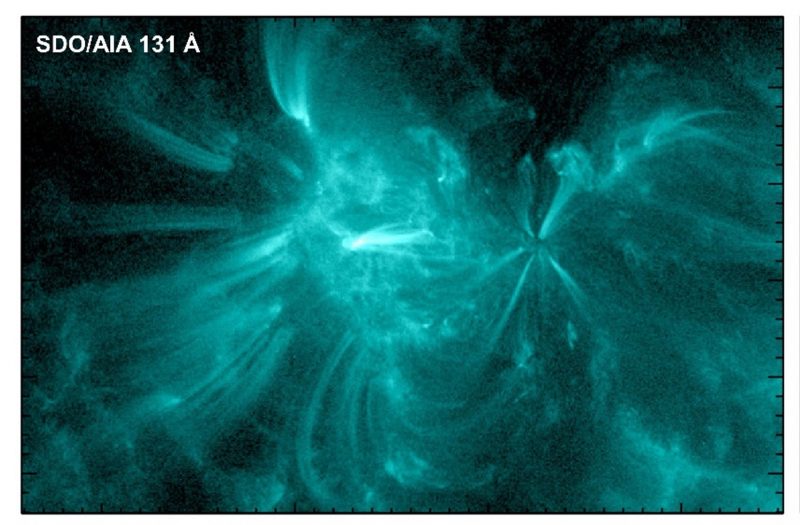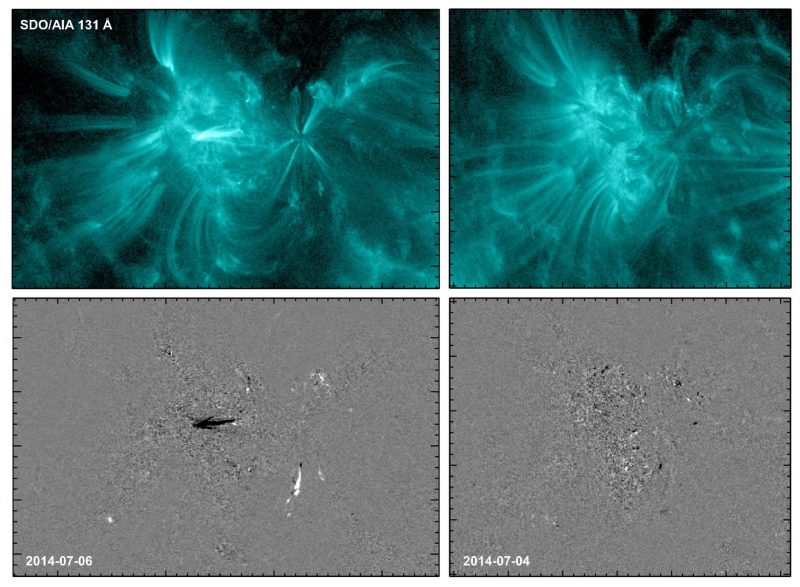
NASA originally posted this article on January 17, 2023. Edits by EarthSky.
A clue to predicting solar flares
A team of scientists has found new clues in the sun’s blazing upper atmosphere that could help predict when and where the sun’s next flare might explode. Using data from NASA’s Solar Dynamics Observatory (SDO), researchers from NorthWest Research Associates (NWRA) identified small signals in the upper layers of the solar atmosphere. These signals in this upper layer – the corona – can help identify which regions on the sun are more likely to produce solar flares. Solar flares are energetic bursts of light and particles released from the sun. The scientists found that above the regions about to flare, the corona produced small-scale flashes, like small sparklers before the big fireworks.
This information could eventually help improve predictions of flares and space-weather storms. Space-weather storms are disrupted conditions in space caused by the sun’s activity. Space weather can affect Earth in many ways. These include producing auroras, endangering astronauts, disrupting radio communications and even causing large electrical blackouts.
Active regions can produce flashes on the sun
Scientists have previously studied how activity in lower layers of the sun’s atmosphere – such as the photosphere and chromosphere – can indicate impending flare activity in active regions. These active regions are often marked by groups of sunspots, or strong magnetic regions on the surface of the sun that are darker and cooler compared to their surroundings. The new findings, which the peer-reviewed The Astrophysical Journal published on January 16, 2023, add to that picture.
KD Leka, lead author and a designated foreign professor at Nagoya University in Japan, said:
We can get some very different information in the corona than we get from the photosphere, or ‘surface’ of the sun. Our results may give us a new marker to distinguish which active regions are likely to flare soon and which will stay quiet over an upcoming period of time.
Reviewing old data for flashes on the sun
For their research, the scientists used a newly created image database of the sun’s active regions captured by SDO. The publicly available resource, described in a companion paper also in The Astrophysical Journal, combines over eight years of images taken of active regions in ultraviolet and extreme-ultraviolet light. Led by Karin Dissauer and engineered by Eric L. Wagner, the NWRA team’s new database makes it easier for scientists to use data from the Atmospheric Imaging Assembly (AIA) on SDO for large statistical studies.
Dissauer said:
It’s the first time a database like this is readily available for the scientific community, and it will be very useful for studying many topics, not just flare-ready active regions.
The NWRA team studied a large sample of active regions from the database, using statistical methods developed by team member Graham Barnes. The analysis revealed small flashes in the corona preceded each flare. These and other new insights will give researchers a better understanding of the physics taking place in these magnetically active regions. The goal is to develop new tools to predict solar flares.
Dissauer said:
With this research, we are really starting to dig deeper. Down the road, combining all this information from the surface up through the corona should allow forecasters to make better predictions about when and where solar flares will happen.
Capturing flashes on the sun

Bottom line: Using data from NASA’s Solar Dynamics Observatory, scientists have found that flashes on the sun could help them predict the next solar flare.











